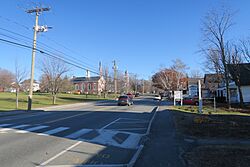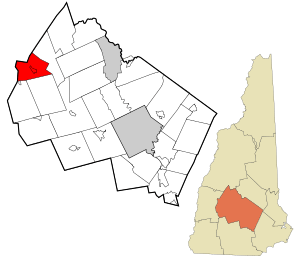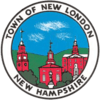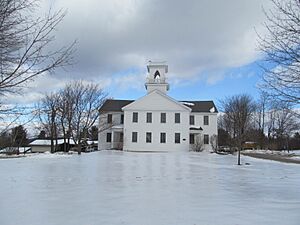New London, New Hampshire facts for kids
Quick facts for kids
New London, New Hampshire
|
||
|---|---|---|

Main Street
|
||
|
||

Location in Merrimack County and the state of New Hampshire
|
||
| Country | United States | |
| State | New Hampshire | |
| County | Merrimack | |
| Incorporated | 1779 | |
| Villages |
|
|
| Area | ||
| • Total | 25.42 sq mi (65.84 km2) | |
| • Land | 22.34 sq mi (57.86 km2) | |
| • Water | 3.08 sq mi (7.98 km2) 12.12% | |
| Elevation | 1,291 ft (393 m) | |
| Population
(2020)
|
||
| • Total | 4,400 | |
| • Density | 197/sq mi (76.0/km2) | |
| Time zone | UTC-5 (Eastern) | |
| • Summer (DST) | UTC-4 (Eastern) | |
| ZIP codes |
03257 (New London)
03233 (Elkins) |
|
| Area code(s) | 603 | |
| FIPS code | 33-52100 | |
| GNIS feature ID | 0873682 | |
New London is a charming town located in Merrimack County, New Hampshire, United States. In 2020, about 4,400 people lived here. It's home to Colby–Sawyer College, which has hosted important science meetings called the Gordon Research Conferences since 1947.
The main part of town, where 1,266 people lived in 2020, is known as the New London census-designated place (CDP). This area sits on a hilltop, near New Hampshire Route 114, Route 11, and Interstate 89.
Contents
Discover New London's Past
Early Beginnings: Heidelberg and Alexandria Addition
Back in 1753, a group of landowners from Portsmouth, New Hampshire, called the Masonian Proprietors, first named this area "Heidelberg." However, no one settled here, so the land grant eventually expired.
In 1773, a new group of investors received the same land. They called it the "Alexandria Addition." These investors were led by Jonas Minot from Concord, Massachusetts, and many others were Scotch-Irish immigrants from Londonderry, New Hampshire. They didn't build homes themselves. Instead, they encouraged settlers to come and build roads, mills, schools, and churches. This helped increase the value of their land. Most of the first settlers came from Massachusetts.
Becoming the Town of New London
By 1779, sixteen families had moved into the Alexandria Addition. They asked the General Court (which was like the state government back then) to officially make their settlement a town. They named it "New London." This name honored London, England, and also recognized the investors from Londonderry. The very first town meeting happened on August 3, 1779.
In 1807, the northern part of New London was combined with another area called "Kearsarge Gore." This new area then became the town of Wilmot, New Hampshire. Later, in the early 1800s, New London grew a little with three small additions, including the village of Otterville in 1817.
Important Events in the 20th Century
In 1947, Colby–Sawyer College became the yearly meeting place for the Gordon Research Conferences. These conferences bring together scientists from all over the world to discuss new research.
Exploring New London's Geography
New London covers about 65.8 square kilometers (about 25.4 square miles). Most of this area, about 57.9 square kilometers (22.3 square miles), is land. The rest, about 7.98 square kilometers (3.08 square miles), is water. This means water makes up about 12% of the town!
Lakes and Rivers in New London
New London is home to several large and beautiful lakes:
- Lake Sunapee forms the western edge of the town.
- Little Sunapee Lake is just north of the town center.
- Pleasant Lake is located on the eastern side.
The western part of town, including Lake Sunapee and Little Sunapee, is part of the Connecticut River watershed. This means water from these areas flows into the Sugar River, and then into the Connecticut River. The central and eastern parts of town are part of the Merrimack River watershed. Water from these areas flows into the Lane River, Warner River, or Blackwater River, which eventually join the Merrimack River.
The highest point in New London is Morgan Hill, which is about 1,770 feet (539 meters) above sea level.
Roads and Nearby Towns
Interstate 89 runs through New London, with two exits serving the town. Other important roads include New Hampshire Routes 11, 103A, and 114.
New London shares its borders with several other towns:
- To the north: Springfield
- To the east: Wilmot
- To the southeast: Sutton
- To the south: Newbury
- To the west: Sunapee
New London's Population
| Historical population | |||
|---|---|---|---|
| Census | Pop. | %± | |
| 1790 | 311 | — | |
| 1800 | 617 | 98.4% | |
| 1810 | 692 | 12.2% | |
| 1820 | 924 | 33.5% | |
| 1830 | 913 | −1.2% | |
| 1840 | 1,019 | 11.6% | |
| 1850 | 945 | −7.3% | |
| 1860 | 952 | 0.7% | |
| 1870 | 959 | 0.7% | |
| 1880 | 875 | −8.8% | |
| 1890 | 799 | −8.7% | |
| 1900 | 768 | −3.9% | |
| 1910 | 805 | 4.8% | |
| 1920 | 701 | −12.9% | |
| 1930 | 812 | 15.8% | |
| 1940 | 1,039 | 28.0% | |
| 1950 | 1,484 | 42.8% | |
| 1960 | 1,738 | 17.1% | |
| 1970 | 2,236 | 28.7% | |
| 1980 | 2,935 | 31.3% | |
| 1990 | 3,180 | 8.3% | |
| 2000 | 4,116 | 29.4% | |
| 2010 | 4,397 | 6.8% | |
| 2020 | 4,400 | 0.1% | |
| U.S. Decennial Census | |||
According to the census from 2010, there were 4,397 people living in New London. There were 1,666 households, which are groups of people living together in one home.
Most of the people in New London are white (96.5%). There are also smaller groups of African American (1.1%), Asian (1.1%), and people from two or more races (1.2%). About 1.5% of the population identified as Hispanic or Latino.
About 13.3% of the population was under 18 years old. About 22.6% were between 18 and 24, and 30.7% were 65 years or older. The average age in New London was 48.7 years.
Fun Places to Visit in New London
- Colby–Sawyer College: This is a small college where you can study different subjects. It has a gym that is open to the public.
- Lake Sunapee: This huge lake is over 4,000 acres! It's a great spot for fishing, with both cold and warm water fish. Many people visit in the summer. Part of the lake is in New London.
- Little Sunapee Lake: This is a clean, smaller lake on the west side of town. It has both public and private beaches. Bucklin Beach is a public beach, but parking is only for town residents.
- Pleasant Lake: Located on the east side of town, this lake has public beach access at Elkins Beach. You can often see fireworks here on the Fourth of July!
- New London Barn Playhouse: This is New Hampshire's oldest summer theater! Each summer, they put on musicals and plays that are very popular with both locals and tourists. It's been a historic place since 2006.
- First Baptist Church: Built in 1826, this church has a classic New England design. It was designed by a famous church architect named Asher Benjamin. It's listed on both the National and State Registers of Historic Places.
- Mount Kearsarge: This mountain is a big landmark you can see from New London. It's in the nearby towns of Warner and Wilmot. You can hike to the top from Winslow State Park, which is about a 15-minute drive away.
- Mount Sunapee Resort: About 20 minutes south of town, this resort is perfect for skiing and snowboarding in winter. In summer, you can enjoy hiking, zip-lining, rock climbing, mini-golf, and even Segway tours!
- New London Historical Society: Here, you can take guided tours of a museum filled with old carriages and sleighs. They also have a 19th-century village that shows what rural New England life was like long ago.
- The Ice House Museum: This museum has a collection of old cars and other interesting American items.
- New London Town Green: During the summer, you can enjoy free concerts here on Friday nights. The first weekend in August is "Hospital Day," which includes a small carnival, a parade, and a triathlon to help raise money for the local hospital.
Famous People from New London
- John F. Bateman (1914–1998): An American football player and coach.
- Tomie dePaola (1934–2020): A very popular children's book writer and illustrator.
- Minnie Mary Lee (1825–1903): A writer whose real name was Julia Amanda Sargent Wood.
- Pamela Low (1928–2007): A flavor expert who helped create the famous flavor for Cap'n Crunch cereal.
See also
 In Spanish: New London (Nuevo Hampshire) para niños
In Spanish: New London (Nuevo Hampshire) para niños



